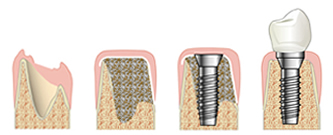Implants
When teeth are lost due to gum diseases, fractures
or large decay, they can often be replaced by dental implants. Dental
implants are small titanium fixtures that are placed into the bone.
Dental implants are made out of titanium because it has the unique
quality of not being rejected by the body (it is bio-compatible).
More importantly, the bone attaches directly to the titanium dental
implant; a term called osseo integration (Osseo=bone; it integrates
into the bone). This procedure has been around for at least 40 years
and has been proven to be very safe. Many improvements to the implants
and the technique have been made so that the procedure is easier
to tolerate and has fewer risks.
In order to be a candidate for dental implants you must have enough
bone in the area to anchor an implant and have healthy gums. There
may also be certain medical conditions that can impact on the success
of the implant. Additionally, when a tooth has been removed, the
bone in the area tends to wear away over time. This may not leave
enough bone to hold the implant. Sometimes, the bone levels can
be replaced in the form of a bone graft, but each situation must
be evaluated before this can be determined.
Uses of Implants
Implants may be used in a variety of different
situations. Sometimes implants are placed to replace a single tooth.
In these situations the titanium implant can be considered as a
replacement for the root that can then be used to anchor the crown
part
Implants may also be used to support bridges. In these situations,
two implants may be used to replace three teeth in the manner of
a conventional bridge. Larger bridges to replace a greater number
of teeth are also done quite routinely.
Implants are very useful in situations where all of the upper or
all of the lower teeth are missing. Multiple implants may be placed
and a patient may be able to enjoy permanent teeth that are fixed
in place and don’t have to be taken out at night.
In other cases, a patient may opt for as few 2 implants and this
can be used to help support a denture that the patient finds does
not hold as well as they would like. This treatment offers a tremendous
improvement in the quality of life.
Prior to determining the best way to provide implant supported teeth,
each individual must undergo a thorough clinical exam with the appropriate
radiographs. Important factors are the overall health, the ability
of the person to keep their teeth and gums clean, the intra-oral
health; the way the teeth fit together and the force of the bite.
Implant Procedures
Sometimes the decision to place an implant is
made when the tooth is still in the mouth. In this situation, the
tooth must first be extracted. When the tooth has been taken out,
it might be necessary to place a bone graft at the time of extraction.
This is done to maintain the amount of bone that is present to ensure
that the implant may be placed. In some instances, the implant can
be placed at the same time that the tooth is removed, this is called
an immediate implant. Each situation must be evaluated individually
in order to determine if this is possible.

In most cases, there is a delay of 2-4 months from the time the
tooth was extracted to the time that the implant is placed. This
allows the bone and gum to heal. At the next stage the implant is
placed. Generally, the procedure to place the implant is not very
long and there is minimal post-operative discomfort.

Sometimes the implant is placed in a one-stage procedure. In these
cases there is a part of the implant or a connector (abutment) that
sticks out of the gum. When a one-stage procedure is performed,
after the period of integration (3-6 months) the patient can go
to the dentist and the crown can be placed immediately.
 
Sometimes it is beneficial to have the implant buried under the
gum at the time of placement. In these situations, it is not visible
during the integration period. When this is done, a second stage
is required to uncover the implant. The decision to use a two-stage
procedure is based on many different variables and each case must
be assessed individually.
Implant types
There are many different types and shapes of
implants. Although collectively we have worked with implants from
different manufacturers, we will only place implants that have come
from companies with a proven track record of long term results and
solid research and development.
|
 |



